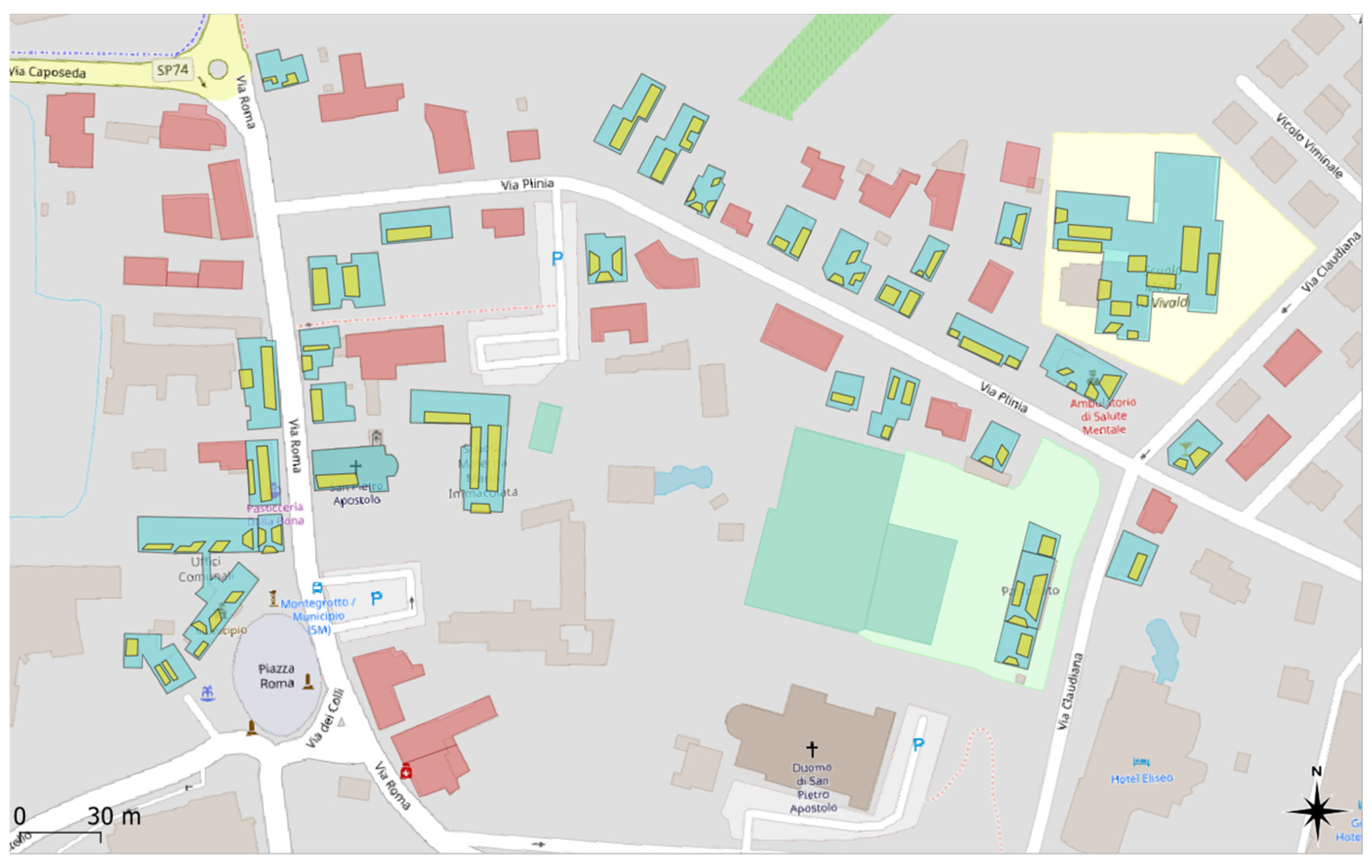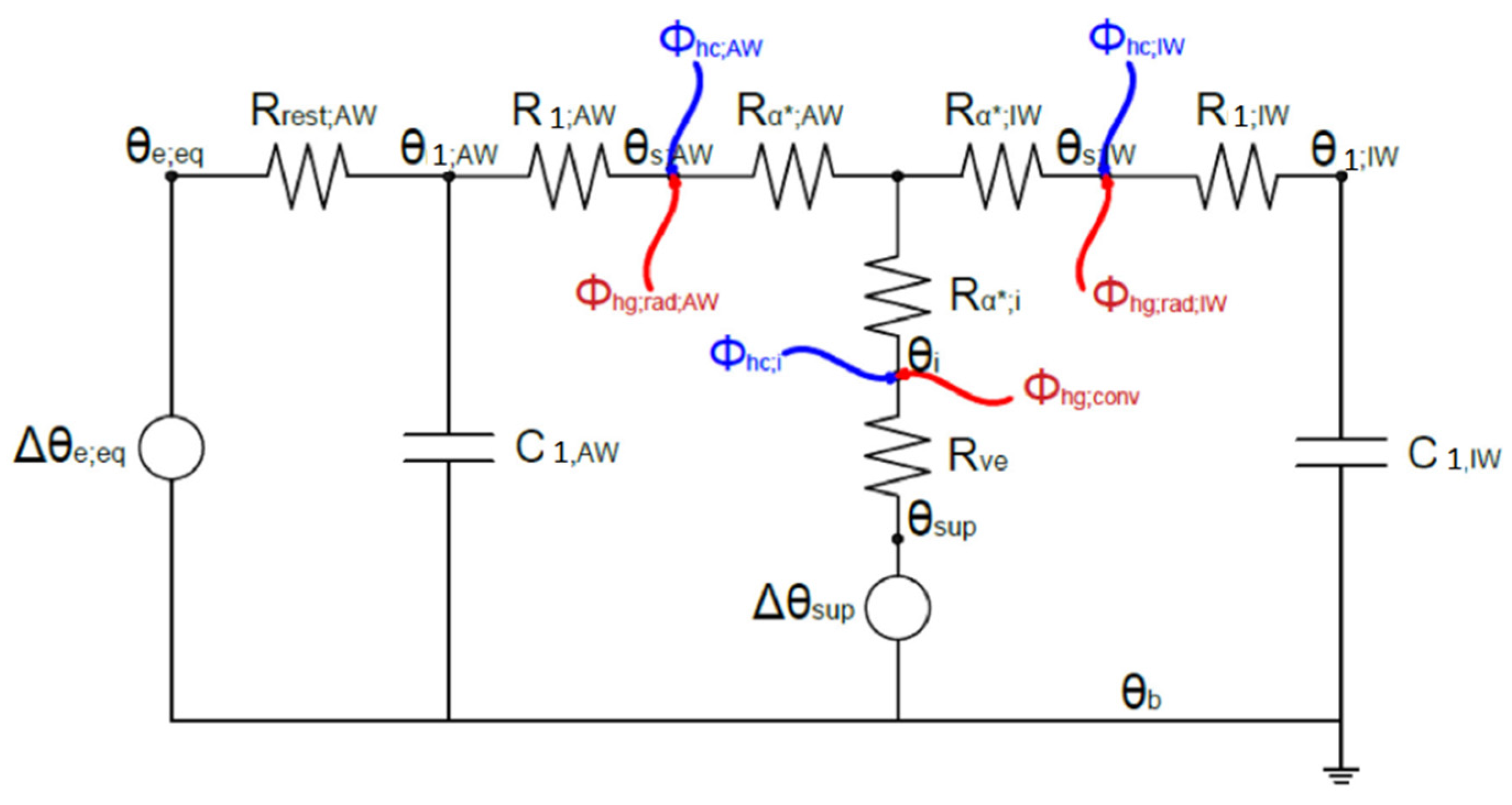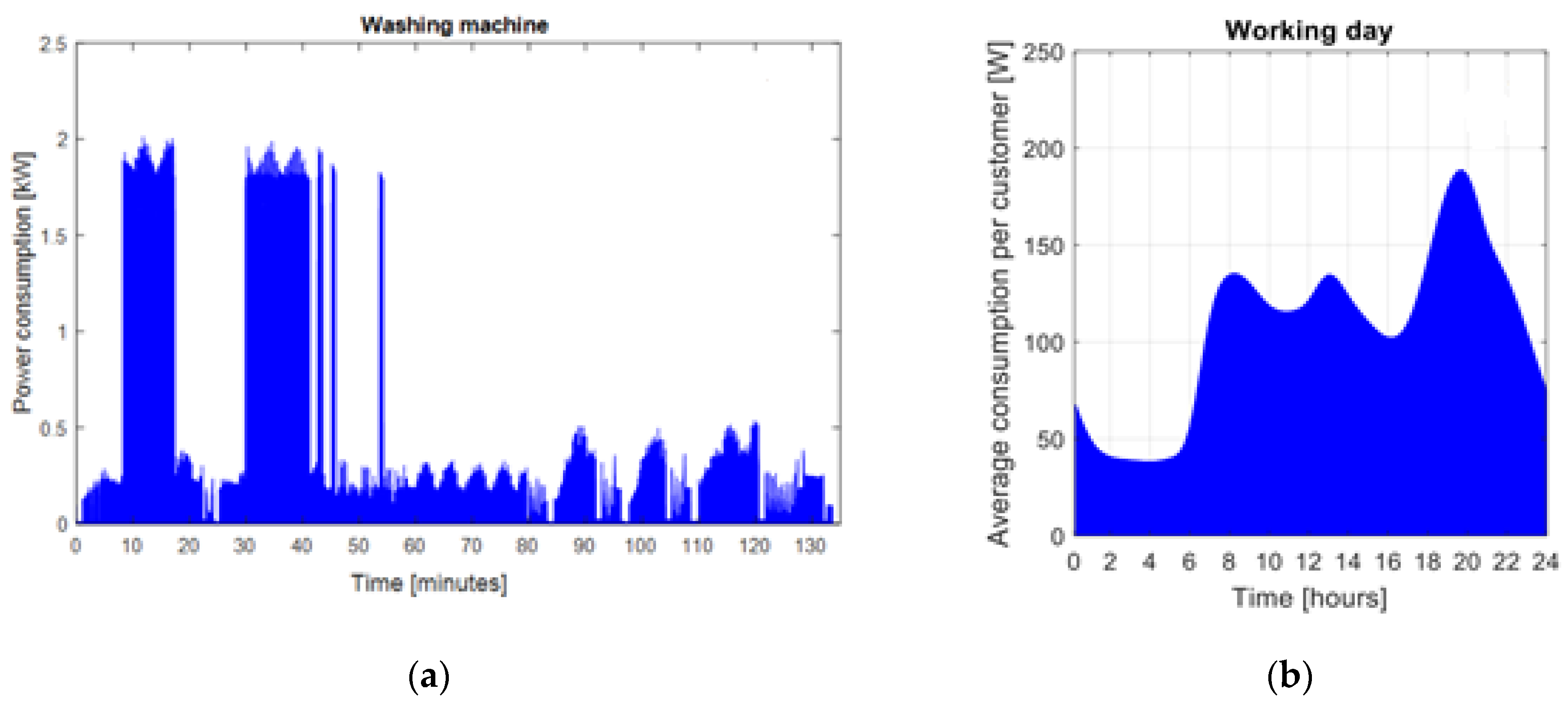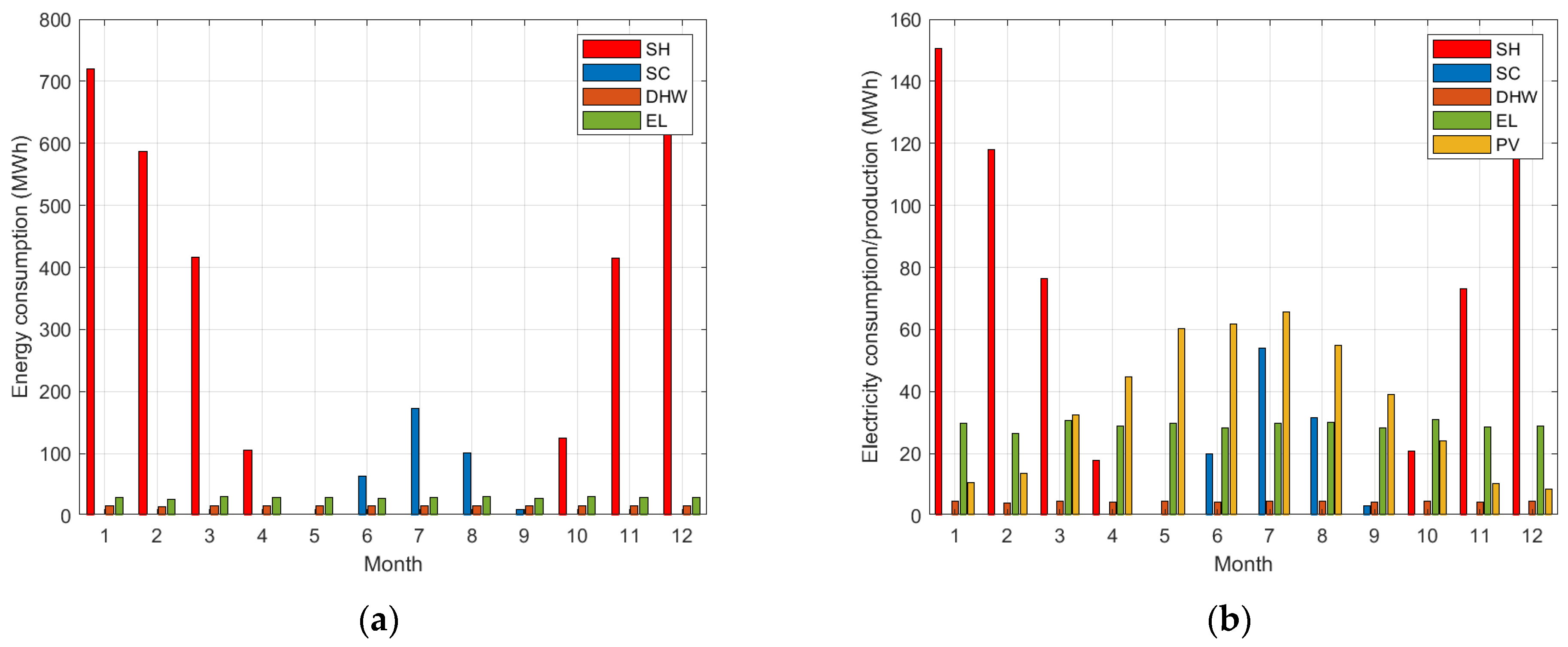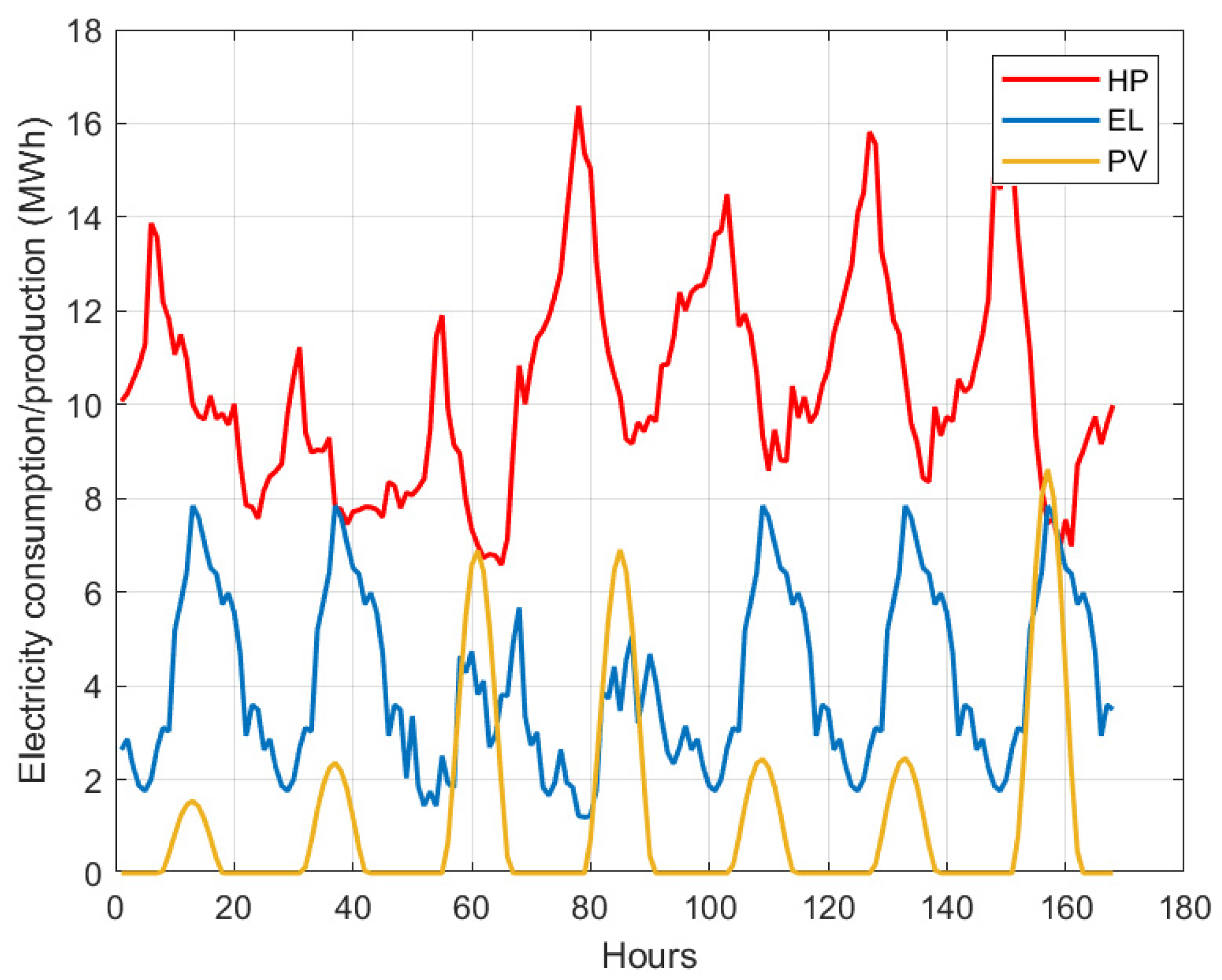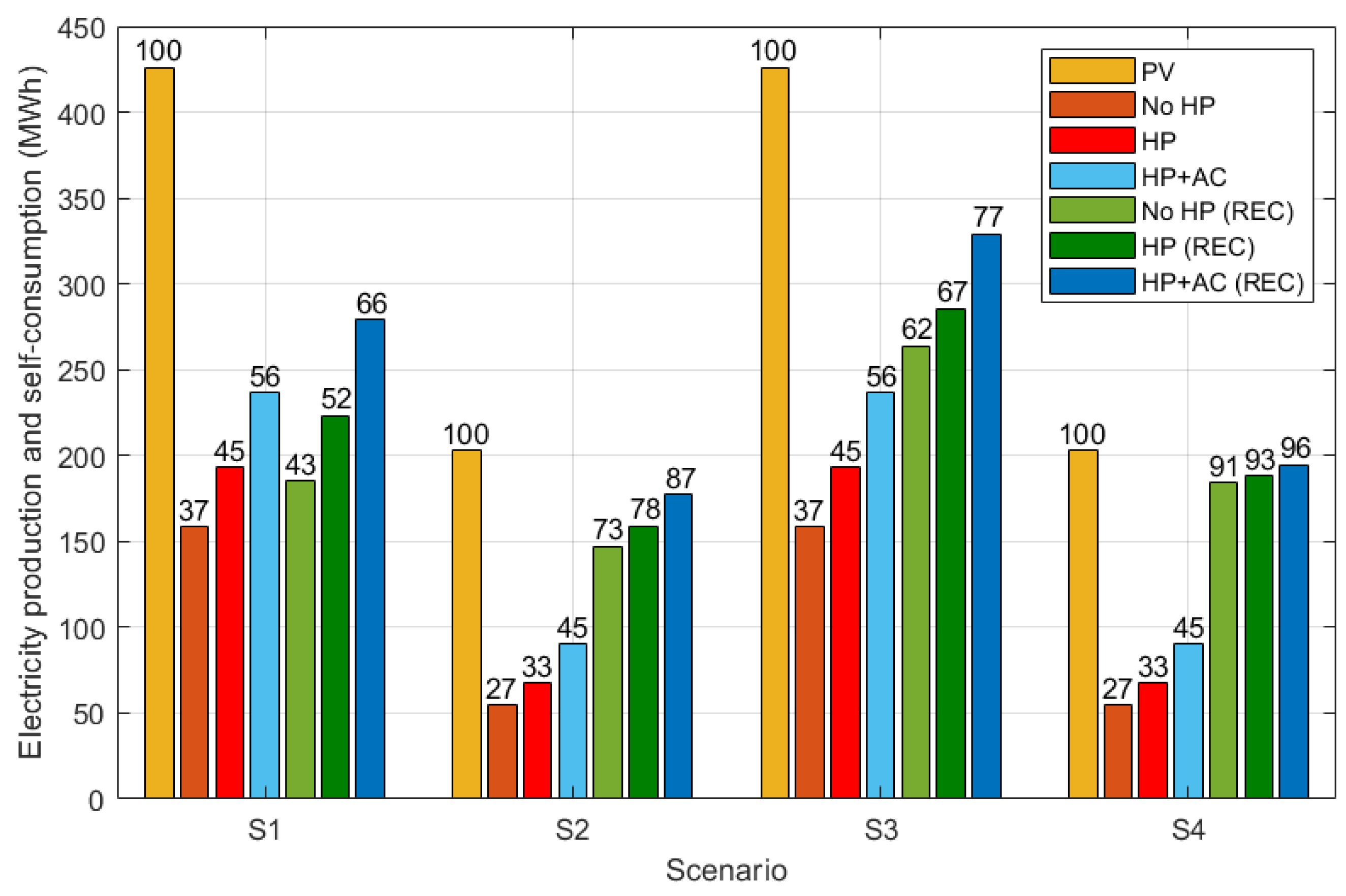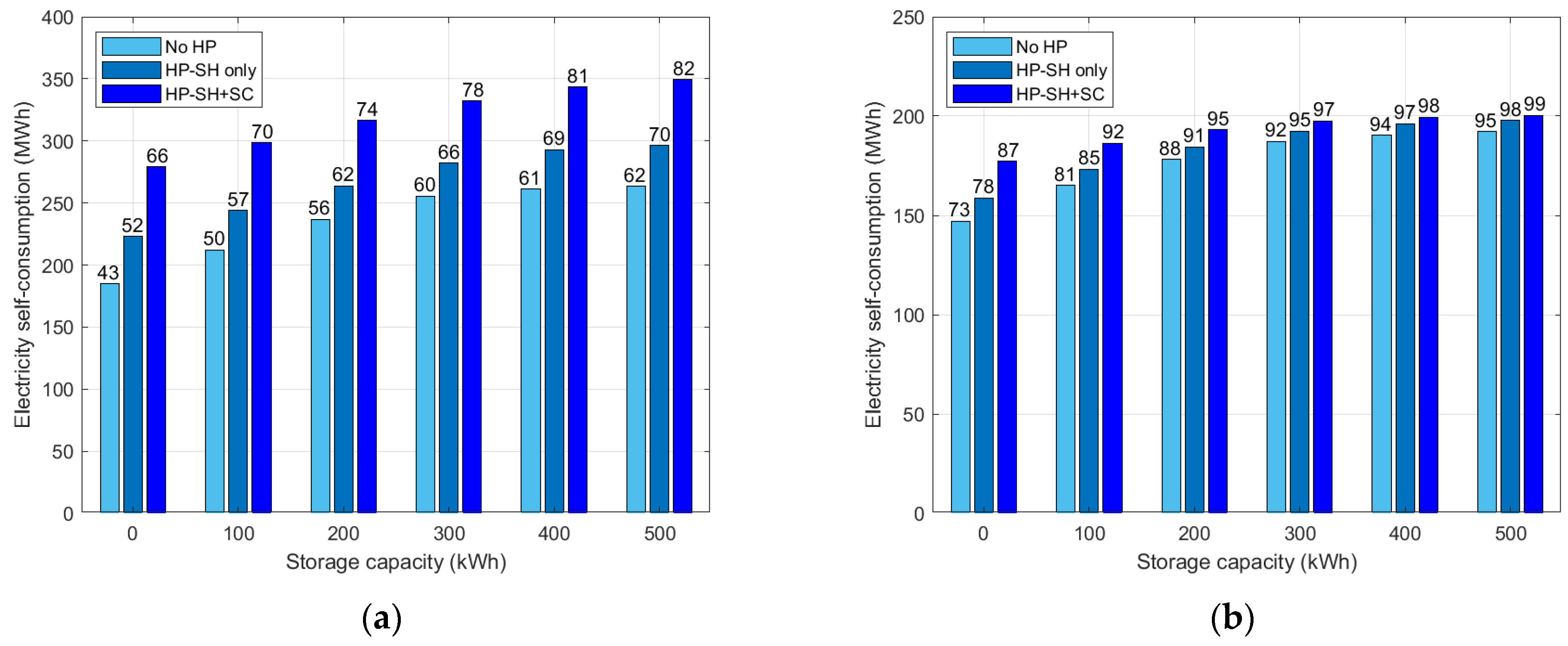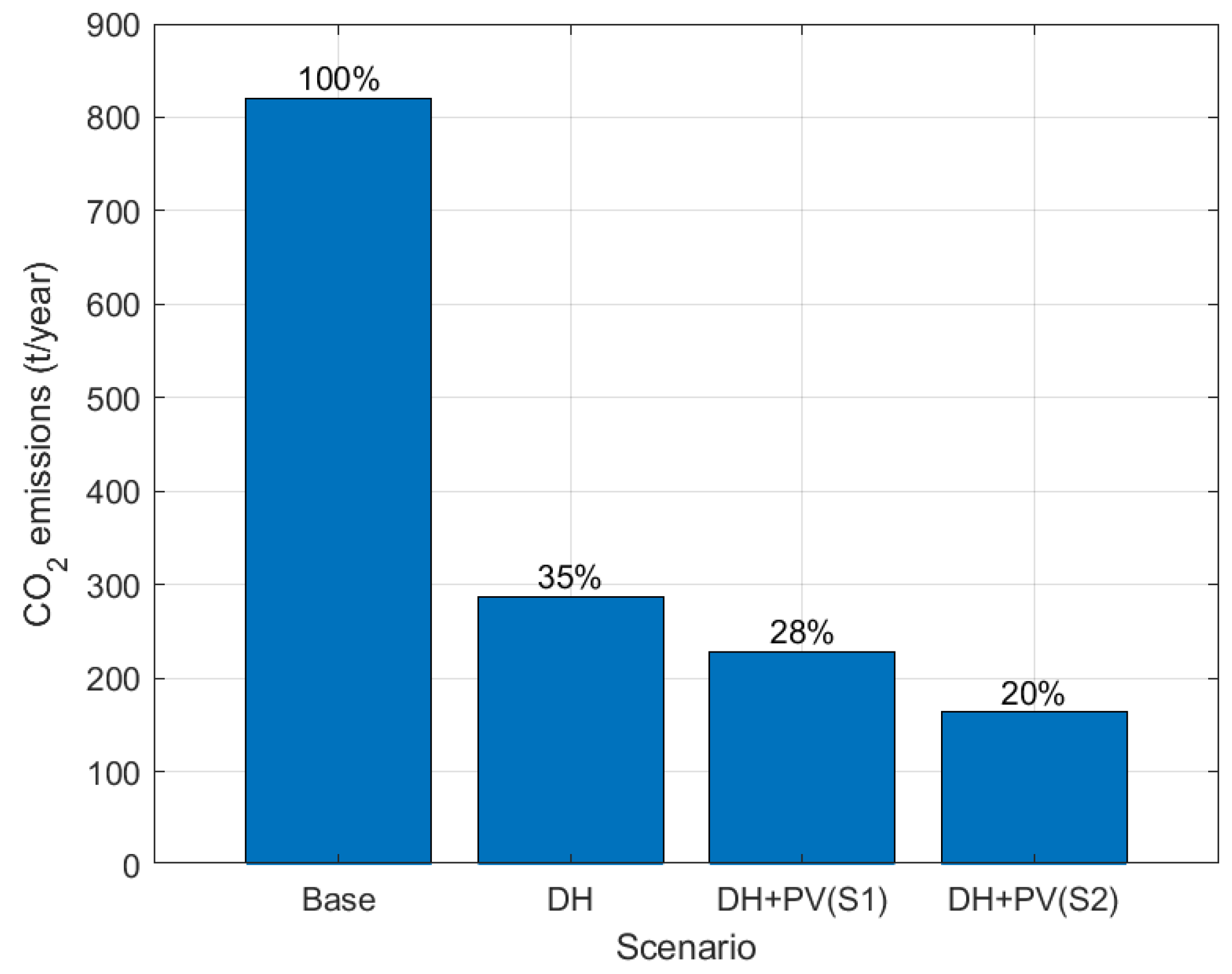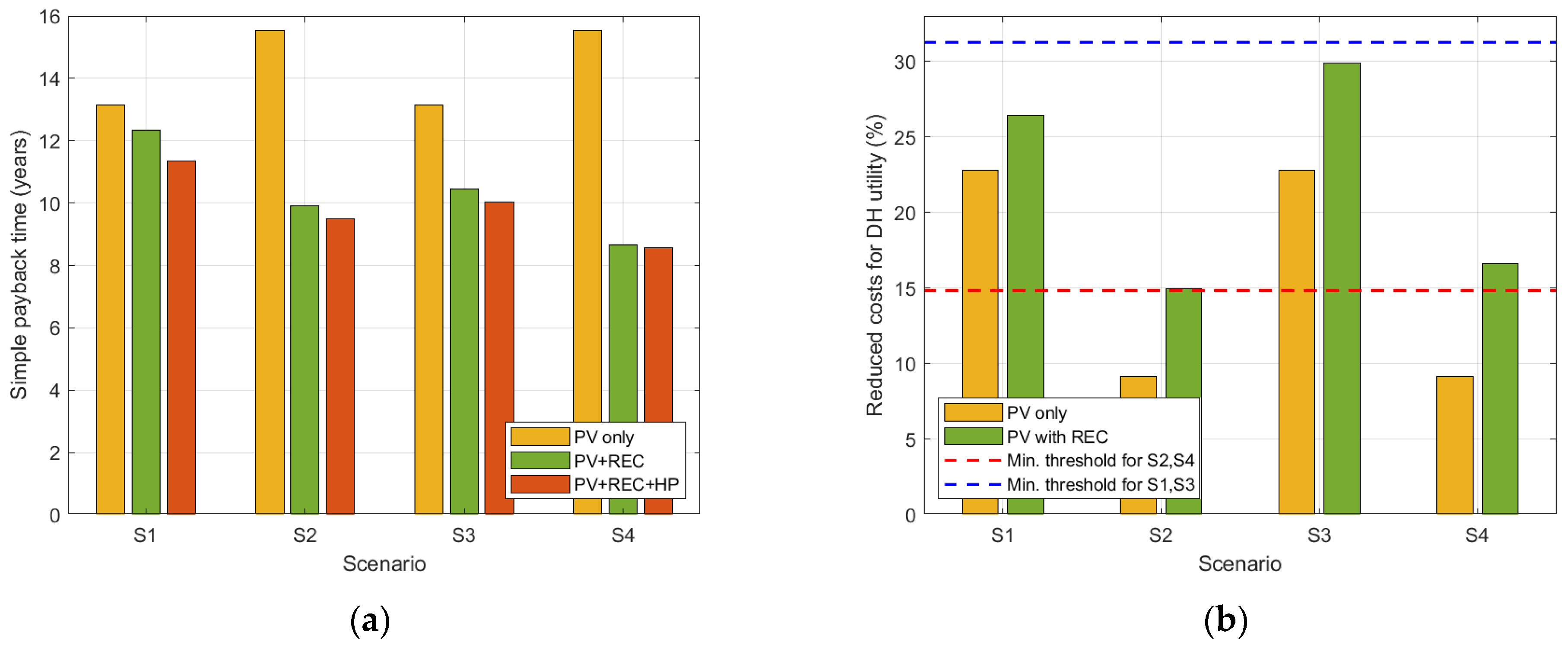1. Introduction
Recently, the Renewables Energy Directive introduced a legal framework for Renewable Energy Communities (RECs), i.e., cooperative organisations for the development of local energy initiatives with non-commercial purposes. The shareholders or members of the REC may be natural persons, small medium enterprises or local authorities, including municipalities, whose primary purpose is to provide environmental, economic or social community benefits rather than financial profits [
1]. According to Koirala et al. [
2], Energy Communities (EC) help re-organize local energy systems to integrate distributed energy resources, engage local communities and at the same time provide useful services to the larger energy system.
As pointed out by Ceglia et al. [
3], smart energy communities are essential to build a sustainable renewable energy system, which is based on a cross-sectoral approach and which seeks the optimal solution from an energy, environmental and economic point of view.
Energy communities have a key role to play in helping citizens and local authorities to invest in renewable energy and energy efficiency projects. The participation of citizens in these projects can also increase the social acceptance of such interventions at local level.
Photovoltaic (PV) systems can be installed on the roofs of public buildings or farms, as well as those of residential buildings, while biomass and biogas can be used in district heating networks [
4].
Ioakimidis et al. [
5] examined the supply of heating and electricity to a small Spanish village using wind turbines, a district heating system supplied by solar collectors and a biomass plant using locally-available straw for base load supply and a fossil fuel boiler for peak load, coupled with a hot water storage tank. The paper pointed out the high investment cost needed for electrical storage system as a financial barrier to the implementation of the proposed system. Bartolini et al. [
6] showed that power-to-gas technologies such as fuel cells could be an economic alternative to battery systems to accommodate high shares of renewable energy production in local energy districts.
Energy Communities enable PV sharing, a practice where a single PV system supplies electricity to more than one dwelling [
7]. This new regulatory framework introduces new opportunities, such as shared investments in local renewable energy projects and building refurbishments.
Garavaso et al. [
8] investigated the optimal refurbishment of a multi-family building considered as an EC using the Energy Hub approach [
9,
10]. The study found out that remuneration on shared electricity has a great impact on the optimal refurbishment as it promotes all-electric scenarios with bigger PV installations.
In particular, for photovoltaics, the analysis carried out by Fina et al. [
7] showed the benefits of energy communities in terms of higher net present value. The value added by an energy community depends on the configuration of the area (condominiums, rural area, historic centre, mixed area), the type of buildings and the number of participants.
Therefore, a later work by the same authors investigated the cost optimal allocation of shared rooftop PV capacities for neighbourhood energy communities (ECs) in rural and urban scenarios [
11]. It was found that it is more advantageous for single houses in rural areas, which can benefit from the presence of diversified loads. In general, PV sharing is more advantageous when heterogeneous load profiles are present and covering the roofs with the largest available surface areas. Furthermore, the results of the analysis show that the economically optimal solution does not require all buildings to have generation facilities.
As pointed out in the survey by Fischer and Madani [
12], the use of heat pumps in smart grids allows to increase grid stability, to promote the integration of renewables and to follow variable electricity prices.
Heat pumps combined with thermal and electrical storage systems can be used within Demand Side Management programs to shave peak loads of power distribution grids [
13], to increase the PV self-consumption [
14], or for market participation [
15]. The same objectives can also be pursued at single building level with Model Predictive Control approaches [
16].
In the last decade, there has been a growing interest towards low temperature district heating networks for the decarbonisation of space heating and cooling of buildings. Several projects around Europe have demonstrated that the so-called fifth generation district heating and cooling networks are able to increase the share of renewable heating and cooling in both new low-energy districts as well as in existing ones [
17].
District heating networks with supply temperatures below 50 °C efficiently supply heat for space heating and domestic hot water (DHW) production to both new and old buildings through high temperature water-to-water heat pumps installed in the users’ substations. This concept is particularly interesting for urban areas where waste or renewable heat can be recovered at low costs [
18]. One of these cases is Montegrotto Terme, a touristic town located in a geothermally active area in the North-East of Italy, where a large amount of groundwater is extracted from the ground, used by hotels and thermal spas, and then released to the environment. The electrical energy demand of heat pump compressors would be the highest operational cost for the operator managing the groundwater-based district heating (DH) network [
18].
To the authors’ knowledge, the self-production and sharing of electricity from local renewable plants for fifth generation district heating and cooling networks has not been investigated so far.
In a preliminary paper presented at the SDEWES conference [
19], the authors investigated to what extent such a thermal network could benefit from a Renewable Energy Community (REC) including all the DH customers and further inhabitants that may share the electricity produced by their PV systems.
The present study shows and discusses the gain brought by the REC with economic and environmental indicators and presents a discussion on the potential of Renewable Energy Communities for fifth generation district heating and cooling systems.
The paper is organized as follows.
Section 2 presents the case study district;
Section 3 the mathematical models to calculate the energy demand profiles;
Section 4 reviews the assumptions, the scenarios and the performance indicators used in
Section 5, where results are shown and discussed. Finally,
Section 6 reviews the main conclusions.
2. Case Study
The case study district, shown in
Figure 1, is a group of 61 buildings in the Municipality of Montegrotto Terme (Italy). Only 32 of them (light blue in
Figure 1) were considered as potential customers for the DH network: 15 residential buildings, 10 mixed-use buildings (approximately 90 residential units and 21 commercial units) and 7 non-residential buildings (2 schools, 2 office buildings, 2 religious buildings and 1 shop). The total heated area is approximately 22,800 m
2. The other buildings (red footprints) are assumed to be potential members of the EC. The footprints of the buildings were sketched with QGIS [
20], thus obtaining dimensions and orientations.
Each building is characterized by its main end use, age class, and number of floors. Only three age classes were considered: buildings from the ’70s (B70), ’90s (B90) and recent constructions built after 2005 (BN). Each age class corresponds to an archetype that defines the stratigraphy of the main building elements, as described in
Table 1. The internal loads were defined according to the main end-use of the building considered: either office, school or residential. Each category was given a different schedule for electric loads (appliances and illumination), occupancy, setpoint temperature of the indoor air and relative humidity and ventilation rates according to Annex C of EN 16798-1 Standard [
21]. In particular, for the heating period (from 15 October to 15 April) the setpoint of temperature was set to 20 °C and for cooling period (from 15 June to 15 September) to 26 °C. In residential buildings the heating/cooling system is always on, whereas in offices it is active from 8 a.m. to 6 p.m. during working days only. In schools, it is on from 6 a.m. to 5 p.m.; a pre-heating of three hours was set to avoid excessive peak loads. It was assumed that there is only natural ventilation with a nominal air change rate of 1.5 volumes/hour during the operating time, to avoid an overestimation of the heat load.
Table 2 shows the nominal values.
4. Methods
From a thermodynamic point of view, the electrical energy of PV systems is more valuable due to its high exergy content and should be used directly as work for mobility, industry etc, while heating and cooling could be satisfied with the production of heat from other sources like solar thermal collectors and waste heat. The exergy imbalance of the proposed system has not been considered in this paper, giving priority to electric heat pumps that show greater flexibility of operation and whose diffusion is expected to increase in the coming years.
4.1. Main Assumptions for District Simulations
The evaporation temperature in the heat pumps was considered constant and equal to 27 °C, considering a network temperature of 40 °C, a difference of temperature from supply and return of 10 °C and a minimum difference of temperature between the two fluids of 3 °C.
The study assumed the same supply temperature curves adopted in a previous analysis [
18]. For the cooling season, only the sensible loads were considered, and they were converted to electric consumption, considering air-to-air systems with a constant COP equal to 3.2. The cooling systems were considered only for the buildings connected at the DH. The photovoltaic systems were designed using the software QGIS [
20], identifying all the available surfaces on the roofs of buildings, using the satellite images, except for north-oriented surfaces –see
Figure 1. Every surface was assigned the azimuth angle and the tilt angle. The nominal efficiency of the modules was set to 15%. The total available area on the considered buildings was around 2815 m
2, that correspond to 422 kW of peak power. The assumptions concerning costs have been summarised in
Table 3, where there is a different electricity price between domestic users and district heating operator. The shared electricity tariff includes the selling price and an incentive set forth in current legislation.
The energy consumption calculated with the models described in the previous section could not be verified against measured data. However, the actual gas consumption was available for seven non-residential buildings. The difference between actual and calculated values varied considerably from building to building (between −46 and +97%, with an average of +22% for simulated thermal energy demand). This difference depends mainly on the uncertainty about their actual use. For three public buildings, the actual electrical consumption was also available from the bills. It was found that the models significantly overestimate the consumption. Therefore, the corresponding profiles were scaled down using a multiplier (0.34).
4.2. Simulated Scenarios
The simulated Renewable Energy Community include both district heating customers and buildings in the surrounding area, as explained in the previous Section. Four different scenarios arise from the combination of EC members and installed PV capacity, as reported in
Table 4. In scenarios S2 and S4, the photovoltaic power was limited at 200 kW, which is the current limit set by the Italian legislation. PV systems were placed on the roofs with the largest area, which seems to be a convenient choice when the PV capacity is limited [
11].
In one scenario, a centralised electric storage was also introduced using a simplified one-node model, with the purpose of evaluating the increase of self-consumption in the REC. Different size of storage were simulated with increments of 100 kWh up to a maximum of 500 kWh. In this model, the level of charge of batteries was calculated every hour, stating from zero and incrementing or reducing by the quantity of electric energy that exceeds or lacks at the consumption of the entire community, until it reaches the maximum or zero. In this model, the efficiency of charge and discharge and the depth of discharge were not taken into account.
4.3. Economic and Environmental Indicators
The electricity consumed by the i-th building
is equal to the sum between the electricity required by the heat pumps (if present) and the electricity consumed for other uses:
The electric self-consumption of the i-th building corresponds to the minimum, in every hour, between the electricity produced and the electricity consumed:
In the case of a building with more housing units the energy consumed is the sum of the energy consumed by each unit. The collective self-consumption of REC was evaluated as the minimum, in every hour, between the energy fed into the grid from photovoltaic systems and the electrical demand of REC members:
where
R represents the set of REC members. For simplicity, all users of the same building were considered participating to the REC. The shared energy is considered as the difference between the collective self-consumption and the sum of the single self-consumption of the buildings:
The cost associated to electricity consumption depends on the amount of shared energy as shown in Equation (9), where the price of energy bought from the grid depends on the type of customer:
where
is the electricity sold to the grid. The simple payback time of DH network and HPs is the ratio between the investment cost and the profit:
where
is the HPs power installed,
is the heat sell to the customers and
is the electricity consumed by the heat pumps. The simple payback time of PV systems depends on the cost of electricity:
where
is the photovoltaic power installed. Finally, the reduction of CO
2 emissions was calculated compared to the current situation without the district heating and the PV systems:
5. Results and Discussion
Authors should discuss the results and how they can be interpreted from the perspective of previous studies and of the working hypotheses. The findings and their implications should be discussed in the broadest context possible. Future research directions may also be highlighted.
5.1. Simulation Results
From the simulations, the thermal energy for space heating is equal to 3015 MWh per year, 187 MWh for DHW production and 348 MWh for space cooling. The electric consumption of HP is 586 MWh for heating, 53 MWh for DHW and 109 MWh for cooling. The electric consumption for other uses is 350 MWh per year and the PV production is 426 MWh with 422 kW installed or 203 MWh with 200 kW installed. The monthly profile of thermal energy end-use and the corresponding electricity needs is reported in
Figure 4 for scenario S1.
It can be seen that in the winter months, the energy requirements for heat pumps were considerably higher than other electrical consumption and photovoltaic production. While in summer months, renewable electricity production exceeded the electrical needs of buildings. In this scenario, an energy community that also involves users without heat pumps seems useful to take full advantage of the energy produced in the summer months. This is even more relevant for buildings with high roof areas but low summer loads, such as schools or other buildings without summer cooling systems.
The previous considerations rely on monthly energy needs. However, matching local electricity supply and demand clearly depends on their simultaneity, that must be analysed on a finer temporal resolution.
Figure 5 shows hourly trends due to heat pump (HP) and other electrical devices (EL) for one week in March for a mixed-use building with three commercial units and ten residential units with low thermal insulation. In addition, the Figure includes the hourly photovoltaic production (PV) for a 20.8 kW system, as assumed for this building based on the available roof area, has been reported. It can be observed that the electrical load of the heat pump is high but discontinuous, as it is influenced by the high fluctuation in the external air temperature between day and night. In this example, the local electrical production is not sufficient to cover the electrical loads but contributes in any case to reduce the withdrawals from the grid.
5.2. Self-Consumption and Energy Sharing in the Considered Scenarios
In
Figure 6, the PV production and the levels of self-consumption are reported for the different scenarios considered. It can be noticed that the self-consumption increases from 5–9% with the introduction of HP for heating and DHW, this limit is caused by the different seasonality of PV production and HP consumption, the first is higher in summer, the second in winter, so there is not a good match between them. With the introduction of a REC, the self-consumption increases by 6–7% in S1 and by 45–46 % in S2. This important difference is caused by the fact that in the first scenario all the buildings have their own PV system, so the advantage of shared electricity is little, whereas in the second scenario only few buildings have the PV systems. In such cases, the REC allows a dramatic increase in the amount of electricity shared by different buildings.
If the Energy Community is enlarged to other users without HP (61 buildings with a total demand of electricity equal to 599 MWh/year), the self-consumption increases by 22–25% in scenario S3 and by 60–64% in scenario S4 with respect to the case without the REC. On the other hand, in this case the benefit of HP is reduced (2–5%). Adding the cooling load, the self-consumption increases by 11% without REC, and by 14% with REC in scenario S1, and by 12% without REC, and by 9% with REC in scenario S2. So, the benefit of cooling loads is more relevant if the PV installed is higher, both with and without REC. With more users in the Community, the advantage of cooling is limited: only 4% in scenario S3 and by 6% in S4. This happens because the higher the self-consumption, the less the additional cooling loads contribute to increasing it.
The electric self-consumption with electrical storage system is reported in
Figure 7 for different storage capacities. Under scenario S1—see
Figure 7a—the self-consumption increases from 43 to 62% without HPs, from 52 to 70% with HPs and from 65 to 82% including the cooling systems. It is possible to observe that the self-consumption reaches an upper limit. The latter is because the electrical energy can be stored daily, which poses no remedy on the seasonal mismatch between power demand and supply. If the PV power installed is low as in Scenario S2, the self-consumption can reach values near 100%—see
Figure 7b. In the latter case, the advantage of additional heating and cooling loads are rather limited.
5.3. Economic and Environmental Indicators
The CO
2 emissions corresponding to the initial situation without the district heating network are reported in
Figure 8, including cases with the DH only and with both DH and PV systems. With the district heating system, the reduction of emissions
is 65%. The reduction reaches 72% and 80% with 200 kW and 422 kW of PV installed, respectively. Emissions are therefore reduced to one third of the initial ones by using a low-temperature waste heat source, and to one fifth by adding photovoltaics. Considering that most of the buildings are old, a refurbishment of some of them would lead to a further reduction in consumption.
Finally, a simple analysis has been conducted to investigate whether the investment in the PV systems pays off from the perspective of the whole Energy Community and from the perspective of the DH utility.
To this end, the simple payback time for PV systems is reported in
Figure 9a, where cooling systems are not considered. The presence of a REC reduces the payback time in all the scenarios due to the incentive on shared electricity. The advantage is more relevant in S2 and S4, because in this case the installed PV power was limited and the shared electricity level was rather high. It can be observed that the presence of HPs reduced the simple payback time, but not as significantly (1.4 to 8.1%) if only SH and DHW were included in the analysis.
Figure 9b shows the reduction in operating costs for the DH utility linked to the local self-production of electricity. The investment in the PV system pays off only when such reduction equals the investment increase for the DH utility, shown by the red and blue dashed lines for the lower and upper PV power installed. This Figure must be interpreted as a worst-case scenario because the low temperature network does not provide space cooling.
It can be observed that investing in PV systems does not lead to a corresponding reduction in operating costs without REC. The latter helps cutting electricity supply costs by 3.6 to 7.4%. Despite such significant improvement, only S2 and S4 scenarios lead to a benefit similar to or greater than the investment, confirming that the correct sizing of the overall PV power is crucial for a cost-optimal sector coupling.
6. Conclusions
This paper analyses the mutual benefits between a low temperature thermal grid with booster heat pumps and a Renewable Energy Community (RECs) based on a shared PV production.
The hypothesis is that self-producing and sharing electricity with distributed rooftop PV-systems would help the utility make fifth-generation district heating and cooling networks more economically convenient and, at the same time, an increase in the electrical demand due to booster heat pumps would be beneficial for the REC members.
To this end, four scenarios were investigated arising from the combination of two levels of nominal PV power and two levels of participation to the REC in an Italian town where a low temperature district heating network is currently under evaluation by the municipal administration. Such a network would be entirely supplied by renewable wastewater at around 40 °C.
The study found out that the benefit brought by the heat pumps to the REC is rather limited due to a seasonal mismatch between summer PV production and winter heating demand. In fact, computer simulations showed that the increase of shared electricity linked to the district heating heat pumps is limited to +9% in the best case.
In the other direction, the possibility to cut operational costs for the DH utility seems to be more attractive because of the incentives put in place for the energy shared among REC members by current Italian legislation.
Results show that the benefit brought by REC depends on the size and number of PV systems installed: there seems to be an optimal aggregated size of installed PV systems that maximizes the collective PV self-consumption.
If the REC includes other users beside those connected to the DH network, the PV self-consumption of the whole community may reach 90% but the relative contribution of the heat pumps is reduced. How to share this benefit between district-heated and other REC members depends on the business model adopted.
In conclusion, the research found out that a PV-based REC could help reduce operational costs for district heating systems with a high number of heat pumps.
These findings lay the groundwork for a possible technical-economic optimization of the system and leaves room for possible innovative business models for the combined sale of heat and energy. Future research could therefore look at the optimal design of Renewable Energy Communities based on multiple PV systems in different electrical demand scenarios. The results that may emerge from such research would be of interest not only to the scientific community, but also to energy service companies and engineering companies that commercialize and/or design renewable energy projects for local communities. In addition, the increasing electrification of the heating and cooling sector and the possibility to produce and share electricity locally need to be further analysed, as they could give rise to new business models based on selling electricity, heat and cooling as a single energy asset. These possibilities need to be supported by an appropriate regulatory framework.
The main limitations of the present study are, on the modelling side, ignoring latent cooling loads during summer and assuming buildings as the smallest consumption units instead of individual apartments. The first assumption leads to an underestimation of self-consumption in summer, while the latter affects the energy sharing figures. In addition, more electricity uses could be considered, such as electric vehicles charging.
